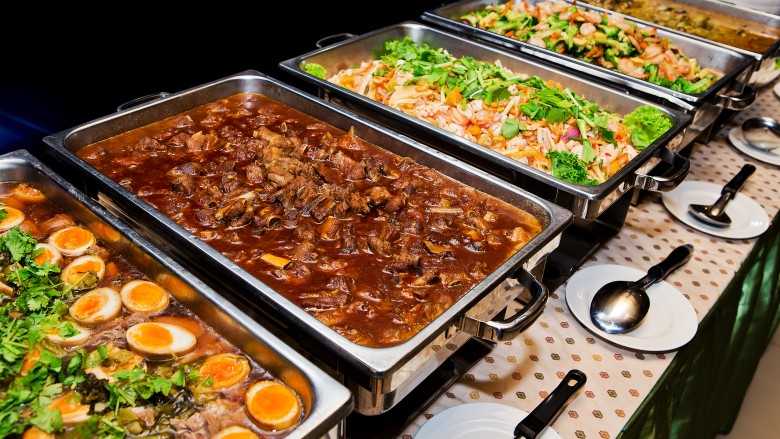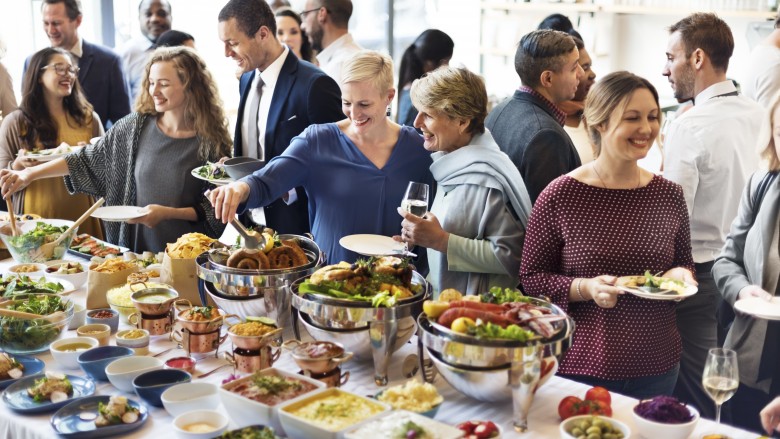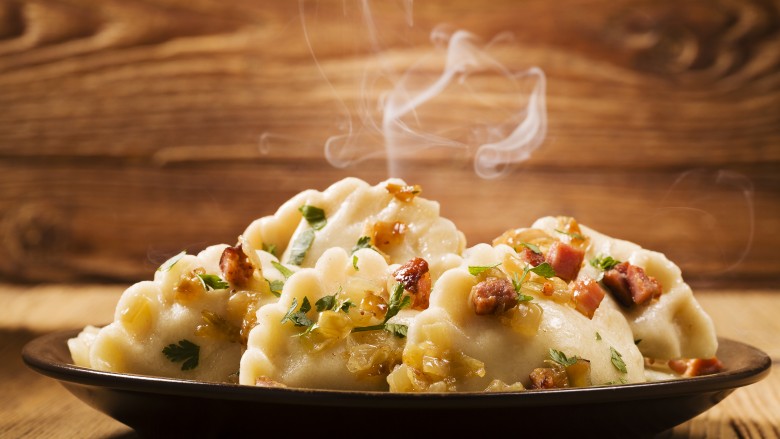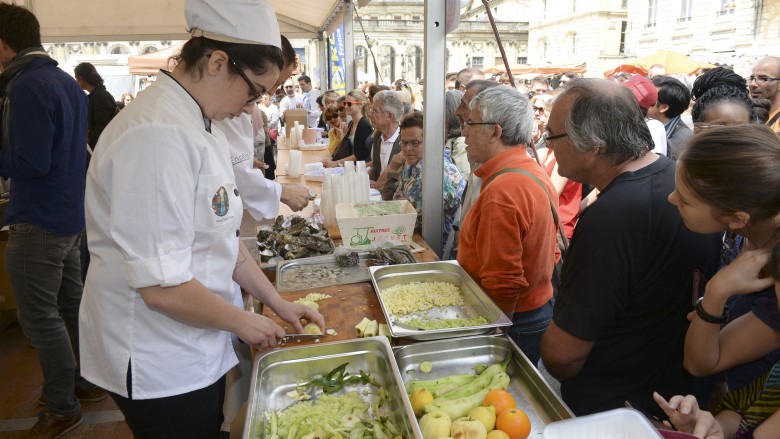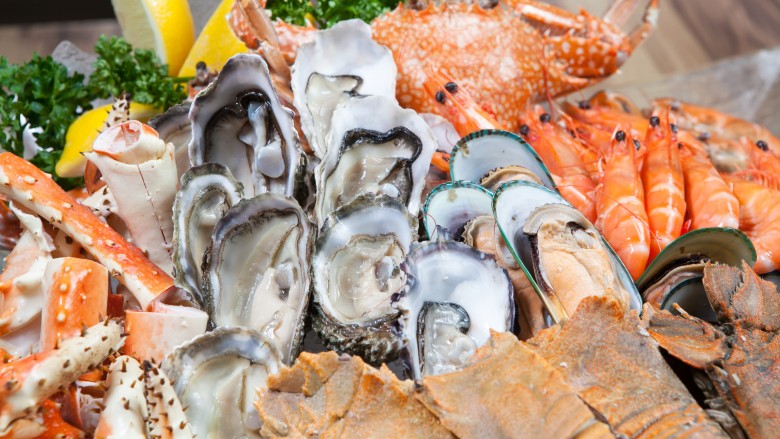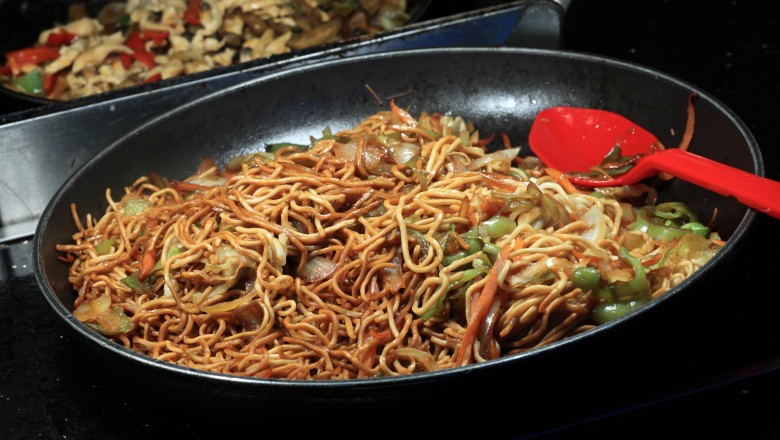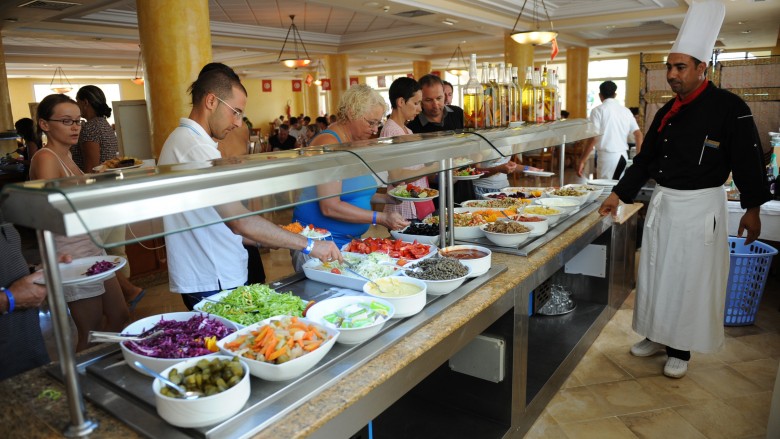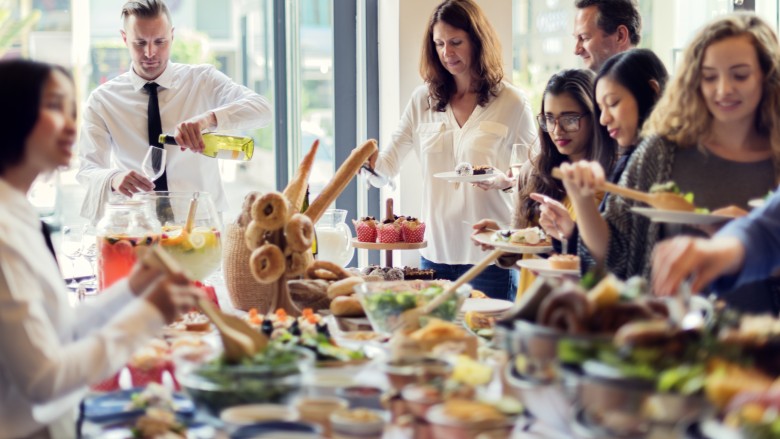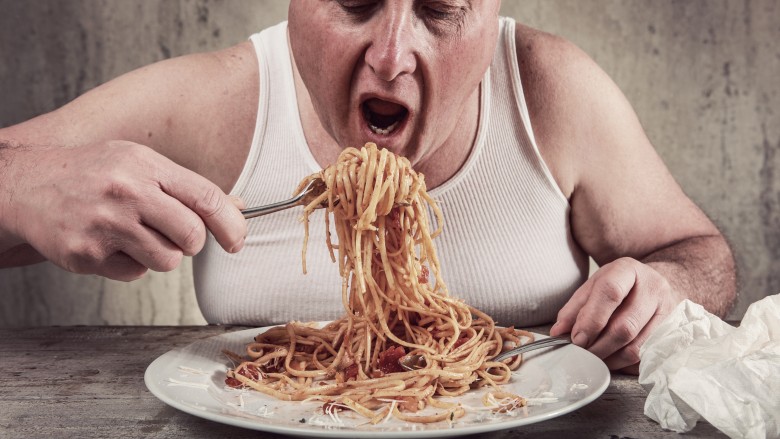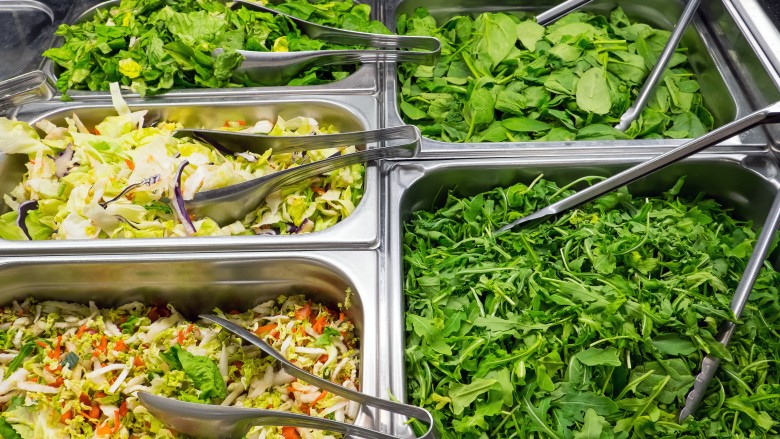The Truth About Buffets
Love them or hate them, buffets are a hugely popular setup in the restaurant world. The idea of the buffet has its roots in the Swedish smorgasbord, which was originally a spread of appetizers — usually meats and cheeses — offered before the main course. The Stockholm Olympics elevated the idea to the world stage in 1912, and the concept was expanded to include the main meal, with everything from soup and salad to dessert and more. Today, buffets are all over, and it's hard to imagine how they could possibly be profitable. But they totally are. Curious as to how it all works? Still want to get the most out of your trip to the buffet? Here's some buffet science and psychology to keep in mind for your next trip to a modern-day smorgasbord.
How can they possibly break even?
For a lot of people, the allure of the all-you-can-eat buffet is the idea that you're getting more than you pay for. From a business standpoint, it might seem like there's nothing about a buffet that would make it successful. There's usually a huge variety, probably a lot of wasted food, and trays of things that would cost a lot more if you were to buy them in a single meal. So what's going on?
The business side of buffets is the key. Buffets usually don't have the same number of staff other restaurants would need, as customers are usually serving themselves. In some buffets, part of the experience is cooking your own food, which also reduces staff. No one's sending their food back to the kitchen with complaints, either; you just push it to the side and get something else. While that might mean food waste, it also cuts back on kitchen workload. And menus are built around what's most efficient to make and cheapest to buy (market prices and menu offerings can change regularly), including things like cheap sacks of vegetables and cheaper cuts of meat.
There's also a balance between who's trying to break the bank. Since most people hit the buffet in groups, for every person eating more food than they actually pay for, there are several who don't overeat. (And not every group has a super-eater.) According to Ovation, the parent company of 330 buffets across the U.S., they keep on the right side of the profit lines by managing waste. They say they've lowered waste to as little as 5 percent per dish, which makes a huge difference in end-of-the-day numbers.
Trying to fill your stomach ASAP
There's a little bit of tricky psychology going on here. We've only got so much room in our stomachs, and buffets count on filling that space quickly. They can do it, too, with low-cost, high-carb foods. Think back to most of the buffets you go to. When you hit the Chinese buffet, what's first on the table? Probably the white rice, fried rice, and noodles. Not a coincidence. A massive scoop of one of these on your plate goes a long way to filling you up without costing the restaurant a whole lot. The same is true for things like fries and mashed potatoes. Some places even give you bigger spoons for foods like this.
Plate size is a huge factor in buffets, too. Most buffets will offer small, half-sized plates, ramekins for soup instead of bowls, and tiny dishes for desserts. That limits how much you can pile on your plate and carry, and once you're back at your table you might rethink whether or not you really need that extra trip up to the line for another go. One thing that's probably huge, though, is the water glass. It's essentially free for the restaurant, and it takes up space in your stomach.
The arrangement of food on a buffet table isn't usually as haphazard as it looks. More expensive food items will typically be surrounded by cheaper ones, and some places might even go as far as to keep the expensive items only partially full, in order to encourage you to take less. That's made even more effective by dividing expensive foods into smaller portion sizes. And some buffets make it difficult to get clean silverware, and if you're at a Chinese buffet you'll probably find chopsticks — which slow down the eating process — are plentiful.
Some buffets are careful not to call themselves "all-you-can-eat," even though they're more than happy to let you go up as many times as you want. Sizzler, for example, calls their buffet "all-you-care-to-eat," which they say is a reminder that gorging yourself just because it's available is bad for your diet and will make you feel worse when you leave. Clearly, they don't want that.
What you're going to eat is weirdly predictable
So how can buffets minimize their food waste when they can't possibly know who's going to be coming in every day and what those customers will want to eat? Science. What you're going to eat is very predictable. The restaurant probably knows what you're going to pile on your plate before you do.
It all has to do with the first thing you see when you get in line. According to a study done by researchers from the Cornell Food & Brand Lab, around two-thirds of what ends up on your plate comes from the first few items you get to. For the experiment, two groups of diners were presented with buffets set up in reverse order. When they kept track of who took what, they found that more than 75 percent of the diners in their experiment took the very first item, no matter what it was. They also found that no matter what was offered first, the overwhelming majority of diners took the first few items, with only around a quarter to half of diners taking what was last in line. The implications have a couple of different applications, from guiding customers to cheaper foods first, or setting up buffets to be healthier by design.
Using buffets to combat food waste
At a glance, the amount of food waste from a buffet might seem like it would be off the charts. But in some areas, buffets are being put to incredibly good use combating food waste. Humans waste enough food every year to feed around two billion people. Go us. In major cities like Los Angeles, New York, Chicago, and San Diego, a new app is starting to catch on. Originally developed in Finland, BuffetGo allows users to purchase end-of-the-day food from major restaurants at a fraction of the price.
On your end, you browse the app, select the restaurant, pick up your to-go box, fill it up, and head out the door. Behind the scenes, what's happening is that you're picking up food that's gone unsold and can't be saved for the following day due to various health regulations. (It's perfectly safe at the end of the day, though.) It's a win-win. You pay a fraction of the price for the same food people have been eating all day, the buffet makes some of its money back, and the food isn't wasted.
The biggest risks
You probably know someone who cringes at the thought of heading out to a buffet. Eating out anywhere is putting a lot of trust in a stranger, and buffets ask you to trust employees and other customers. Fortunately, there are some things that you can keep an eye out for to help protect you and other diners.
When it comes to dangerous foods, you might want to consider giving some of the seafood (particularly raw things like oysters and sushi) a miss. There's a huge potential for illness there, especially when those foods aren't kept at the proper temperature. Aside from improperly cooked or stored foods — which can be a danger anywhere, not just at buffets — the other big danger is cross-contamination. Cross-contamination can also happen anywhere, but buffets have more potential hazards. With all customers serving themselves, there's a huge chance for the transfer of germs on serving utensils. And it isn't hard for someone to use one serving spoon for multiple dishes. This is bad; please don't do it. Long sleeves making contact with the food or serving line is bad, and that's not even mentioning people who might pick up a dinner roll, change their mind and put it back. So to keep yourself safe, look for telltale danger signs like spoon handles touching food, other customers returning with dirty plates, and dishes that don't have their own individual serving spoon or set of tongs. Avoid those things, and maybe let an employee know what's going on.
There are no regulations for serving utensils
The rules that are in place for buffet food and safety are just like other restaurants, which means you might be unpleasantly surprised about some of them. When it comes to the actual food prep, utensils must be swapped out and cleaned every four hours. And on the buffet table, any time a serving utensil actually falls into a dish of food, that food has to be tossed. So you'd expect there to be some rules about the serving utensils, right? Nothing.
Regulations don't extend to serving spoons and tongs, even though there's a huge risk for contamination. That includes everything from someone using the same utensil for more than one dish, to someone who's just come out of the bathroom without washing their hands properly. (And that happens more than you want to think. According to a 2013 study from Michigan State University, only 5 percent of people wash their hands in the CDC recommended manner. Yikes.)
The sneeze guard is pretty recent
Since you're already thinking about buffet safety, let's touch on the sneeze guard. Specifically, about how disturbingly recent it is.
Originally called the Food Service Table, the sneeze guard setup was created by a man named Johnny Garneau. He applied for his patent on March 10, 1959, at least two decades after the first buffets started popping up in America. Garneau was the mastermind behind some of the earliest buffet chains, called American Style Smorgasbord. It only all came together into what we know today because Garneau was both a restaurant owner and a germaphobe.
His invention of the sneeze guard came about solely because he couldn't stand the thought of anyone sneezing or breathing their germs on food that other people were going to eat, and he succeeded in revolutionizing food safety. By the early 1960s, regulations were put in place making these sanitary measures completely mandatory.
The weird relationship between price and enjoyment
Do you love the idea of good food at a good price? You might not. When it comes to buffets, consumers seem to enjoy the food less if they pay less for it. Everyone likes a good deal, don't they? A study from the Cornell Food & Brand Lab suggests that buffets that want to keep their customers happy and satisfied enough to keep coming back need to find something of a sweet spot between price and quality.
Researchers offered customers the same lunch buffet, consisting of pizza, pasta, breadsticks, salad, and soup. Some were charged $4, while others were charged $8. When they were done, they were asked to rate the entire experience. Across the board, diners who were charged $4 reported that they enjoyed it less than the group that had paid $8 and rated their overall experience worse if they had eaten more pizza.
The study's authors suggested that it was something of a self-fulfilling prophecy. If we don't pay much for something, they said, we don't expect much from the experience. We figure that if they're able to still make a profit on what we're paying, we're getting cheap ingredients and a low-quality product. If we're charged a bit more, we feel like we're going to enjoy it more because it must be better food.
Buffet guilt is a very real thing
You know the feeling that starts when you make your last trip up to the buffet. That feeling is in full swing by the time you make it out to the parking lot. You aren't alone. Buffet guilt is real. Cornell's Food & Brand Lab took a look at this one, too. Walking out of a buffet is unlike walking out of a traditional restaurant, and many can't help but feel they've done something they're going to regret. This one was investigated in conjunction with the experiment that gave people either the $4 or $8 pizza buffet. While they were asked how happy they were with their lunch, they were also asked about how they felt after eating.
Those who paid the $4 price were less happy with the quality of the food they got and reported being more physically uncomfortable than those who paid $8. Even if they ate the same amount, the $4 crowd reported feeling like they had overindulged and said they felt guilty regarding what they had eaten and the price they had paid for it. Sound familiar?
Is it possible to eat healthy at a buffet?
If you're trying to eat healthy and pay more attention to what goes from the kitchen to the plate to your fork, visiting the expansive temptation of a buffet might seem like a daunting challenge. But there are some ways to avoid some of the biggest buffet pitfalls and (maybe) some of the buffet guilt.
Take advantage of the small plates on offer. They'll minimize food waste and encourage you to take less food, which might be exactly what you want. Don't opt for a bigger plate, and when you go to your table, make sure you're as far away from the buffet as you can get. Your access isn't as easy, and you don't have to suffer the temptation of people walking past with their own overflowing plates. Don't take a tray, either. The added convenience has been shown to increase what we pile on, so avoid trays at all costs.
Since you know now that the first things you see are the majority of what you take, the experts also suggest that you break that pattern. Don't grab a plate and hop in line; take a look around first. See what's on the menu, and if you know ahead of time that your favorite roast chicken is halfway down the buffet, you're less likely to pile the carbs on your plate before you even get there. And while you might be tempted to go without eating for the day before you hit the buffet, snacking on some fresh veggies before you head out will go a long way in managing the worst of your impulses. Just like eating healthy in other restaurants or at home, it's all about being aware!

